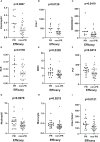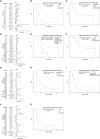Prognostic and predictive significance of circulating biomarkers in patients with advanced upper gastrointestinal cancer undergoing systemic chemotherapy
- PMID: 37346066
- PMCID: PMC10280739
- DOI: 10.3389/fonc.2023.1195848
Prognostic and predictive significance of circulating biomarkers in patients with advanced upper gastrointestinal cancer undergoing systemic chemotherapy
Abstract
Objective: The prognosis of patients with advanced cancers of the upper gastrointestinal (UGI) tract is poor. Systemic chemotherapy forms the basis for their treatment, with limited efficacy. Biomarkers have been introduced into clinical practice for cancer management. This study aimed to investigate the predictive and prognostic values of circulating biomarkers in patients with advanced esophageal and gastric cancers receiving chemotherapy.
Design: Overall, 92 patients with advanced esophageal squamous cell carcinoma (ESCC; n = 38) and gastric adenocarcinoma (GAC; n = 54) were enrolled. We analyzed the association of circulating lymphocyte subsets, inflammatory markers, and blood cell counts with treatment efficacy and patient survival.
Results: Significant differences were identified in peripheral blood parameters between the groups with different clinicopathological features. Hemoglobin (Hb, p = 0.014), eosinophil counts (p = 0.028), CD4+CD28+T/CD4+T percentage (p = 0.049), CD8+CD38+T/CD8+T percentage (p = 0.044), memory CD4+T (p = 0.007), and CD4+CD28+T (p = 0.007) were determined as predictors for achieving non-PD (progression disease) in the ESCC cohort. High levels of eosinophils (p = 0.030) and memory CD4+T cells (p = 0.026) and high eosinophil-to-lymphocyte ratio (ELR, p = 0.013) were predictors of non-PD in patients with GAC. The combined detection models exhibited good ability to distinguish between partial response (PR)/non-PR and PD/non-PD in patients with ESCC and GAC, respectively. Using the multivariate Cox model, the Eastern Cooperative Oncology Group (ECOG) score status (hazard ratio [HR]: 4.818, 95% confidence intervals [CI]: 2.076-11.184, p < 0.001) and eosinophil count (HR: 0.276, 95% CI: 0.120-0.636, p = 0.003) were independent prognostic factors of progression-free survival (PFS) in patients with ESCC. Metastatic sites (HR: 2.092, 95% CI: 1.307-3.351, p = 0.002) and eosinophil-to-lymphocyte ratio (ELR; HR: 0.379, 95% CI: 0.161-0.893, p = 0.027) were independent prognostic factors for overall survival (OS) in patients with ESCC. Differentiation (HR: 0.041, 95% CI: 0.200-0.803, p = 0.010), memory CD4+T (HR: 0.304, 95% CI: 0.137-0.675, p = 0.003), NK cells (HR: 2.302, 95% CI: 1.044-3.953, p = 0.037), and C-reactive protein-to-lymphocyte ratio (CLR; HR: 2.070, 95% CI: 1.024-4.186, p = 0.043) were independent prognostic factors for PFS in patients with GAC. Total lymphocyte counts (HR: 0.260, 95% CI: 0.086-0.783, p = 0.017), CD8+T (HR: 0.405, 95% CI: 0.165-0.997, p = 0.049), NK cells (HR: 3.395, 95% CI: 1.592-7.238, p = 0.002), and monocyte-to-lymphocyte ratio (MLR; HR: 3.076, 95% CI: 1.488-6.360, p = 0.002) were identified as independent prognostic factors associated with OS of GAC.
Conclusion: Lymphocyte subsets, blood cell counts, and inflammatory parameters may predict the chemotherapeutic response and prognosis in ESCC and GAC. A combination of these markers can be used to stratify patients into risk groups, which could improve treatment strategies.
Keywords: biomarker; chemotherapy; esophageal cancer; gastric cancer; prognosis.
Copyright © 2023 Li, Gao, Ge, Zhao, Bai and Wang.
Conflict of interest statement
The authors declare that the research was conducted in the absence of any commercial or financial relationships that could be construed as a potential conflict of interest.
Figures




References
LinkOut - more resources
Full Text Sources
Research Materials

